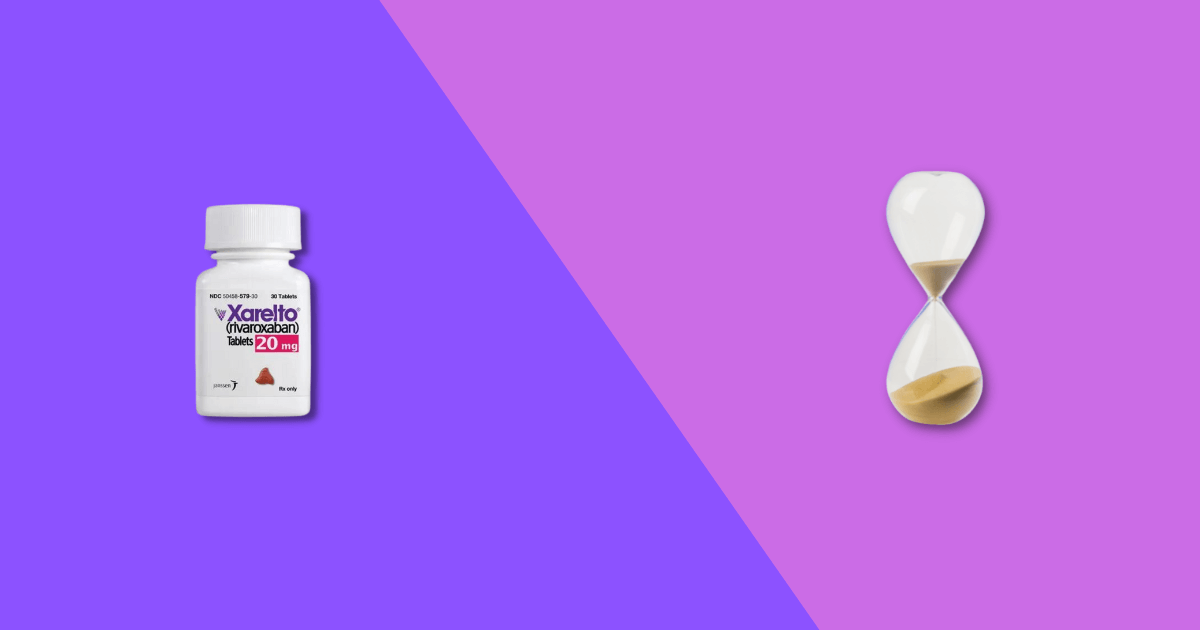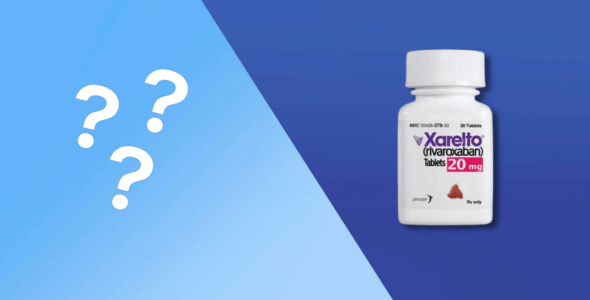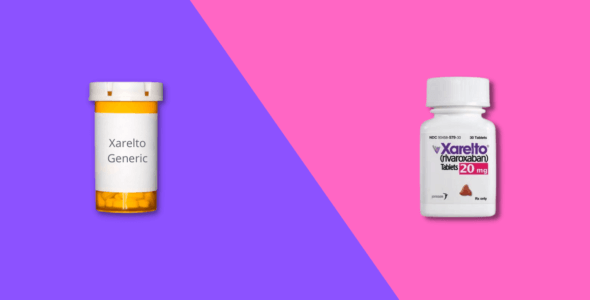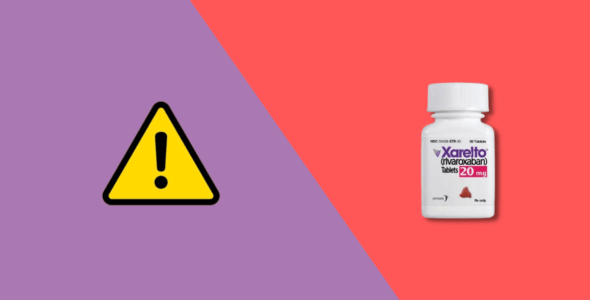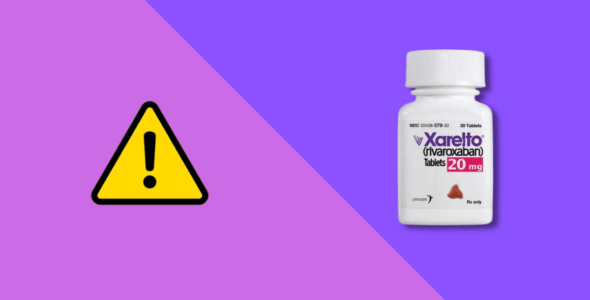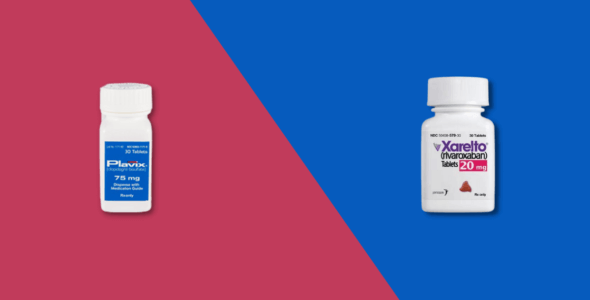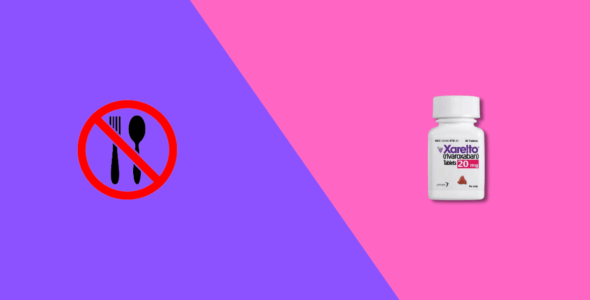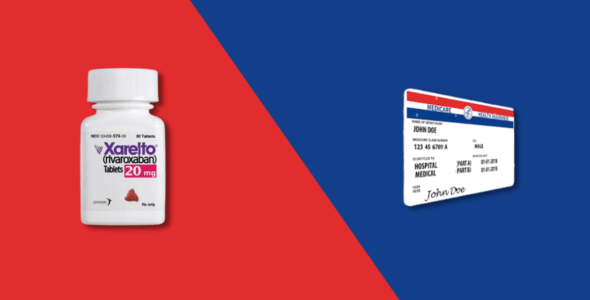How long does Xarelto stay in your system?
Table of contents
Xarelto is the brand name for a prescription drug that contains rivaroxaban as the active ingredient. Rivaroxaban is classed as an anticoagulant and is used to reduce the risk of blood clots forming in the body. Reducing blood clots will help with the prevention of strokes, DVTs, and pulmonary embolisms.
If your doctor has prescribed Xarelto to you, you may want to know more about what it is and how it works. Here we’ll explain what Xarelto is, what it’s used for, how it works, its side effects, what happens when you stop taking it, drug interactions, and much more.
What is Xarelto?
Xarelto (rivaroxaban) is an FDA-approved anticoagulant therapy manufactured by Bayer and Janssen Pharmaceuticals, Inc. It is a blood thinner used to treat deep vein thrombosis (DVT) and pulmonary embolism (PE). Xarelto belongs to a class of medications called direct Factor Xa inhibitors which reduce the chance of blood clots happening and also reduce the risk of coronary heart disease and peripheral artery disease.
What is Xarelto used for?
Xarelto (rivaroxaban) is an FDA-approved medication manufactured by Janssen Pharmaceuticals and Bayer to:
- Reduce the risk of stroke and systemic embolism in patients with nonvalvular atrial fibrillation (irregular heartbeat)
- Treat deep vein thrombosis (DVT), and pulmonary embolism (PE), and reduce the risk of recurrence of DVT and PE
- Prophylaxis of DVT, which may lead to PE in patients undergoing hip replacement surgery or knee replacement surgery
- Prophylaxis of venous thromboembolism (VTE) in acutely ill medical patients
- Reduce the risk of major cardiovascular events in patients with coronary artery disease (CAD)
- Reduce the risk of major thrombotic vascular events in patients with peripheral artery disease (PAD)
- Treatment of VTE and reduction in the risk of recurrent VTE in pediatric patients from birth to less than 18 years
- Thromboprophylaxis in pediatric patients 2 years and older with congenital heart disease after the Fontan procedure
- Prevention of atherothrombotic events in adults who have acute coronary syndromes and increased cardiac biomarkers in co-administration with antiplatelet agents
How does Xarelto work?
Blood clotting is a complex process that helps prevent excessive bleeding events when a blood vessel is injured. Sometimes blood clots form in your body when they are not needed, which can block the flow of blood and lead to stroke or heart attack (myocardial infarction).
The active ingredient in Xarelto is called rivaroxaban. It’s an oral anticoagulant drug, or blood thinner, that reduces the likelihood of clots forming in your blood. Based on Xarelto’s pharmacology, its mechanism of action is the inhibition of a clotting factor in your blood called factor Xa, which plays an important part in the coagulation of blood. By blocking this enzyme, it reduces your risk of blood clots forming. Rivaroxaban essentially has anti-factor Xa activity.
How long does it take for Xarelto to get into your system?
Xarelto will take 2 to 4 hours to reach its maximum plasma concentration and its full blood-thinning pharmacodynamic effect.
How long does Xarelto stay in your system?
Xarelto has a half-life of 5 to 9 hours and will typically take around 25 to 45 hours to clear from your bloodstream.
What is the half-life of Xarelto?
Xarelto has a half-life of 5 to 9 hours in healthy subjects.
What is the half-life of Xarelto in elderly
Xarelto has a half-life of 5 to 9 hours in healthy subjects and 11 to 13 hours in the elderly. Rivaroxaban’s pharmacodynamic effect is closely related to its plasma concentration.
What is rivaroxaban half-life in renal failure?
The clearance of rivaroxaban is reduced in elderly people, mainly due to reduced renal function in the elderly. The half-life of rivaroxaban in people with reduced renal function is 11 to 13 hours.
How long does it take for Xarelto to leave your system?
Xarelto takes around 25 to 45 hours to leave your system completely.
How is Xarelto cleared from the body?
One-third of rivaroxaban is cleared from the body unchanged through the kidneys. The other two-thirds is broken down by the liver. No active metabolites of Xarelto remain in circulation in the body.
How long do blood thinners stay in your system?
This will depend on the blood thinner you have been taking. Blood thinners such as warfarin or clopidogrel may take a few days. Xarelto and Eliquis on the other hand will wear off in around 24 hours.
Can you take Xarelto if you have a stomach ulcer?
You are not advised to take this medication if you have a stomach ulcer as you will be at an increased risk of bleeding from the ulcer and Xarelto may increase this risk.
When should I stop Xarelto for surgery?
Your last dose of Xarelto should be taken one or two days before surgery or any dental procedure. Xarelto has a half-life of 5 to 9 hours and will take around 24 hours to clear out of your system. Speak to your healthcare provider for medical advice if you are thinking about stopping your Xarelto for any reason.
What happens if you stop using Xarelto?
If you discontinue treatment with Xarelto you will be at an increased risk of heart attacks, DVT, strokes, or pulmonary embolism after around 24 hours due to a reduction in its anticoagulant effect.
Can you stop Xarelto cold turkey?
Xarelto does not cause withdrawal symptoms as such but if you stop treatment too early, you are at an increased risk of cardiovascular problems, such as heart attack or stroke.
What are the withdrawal symptoms of Xarelto?
Xarelto has a half-life of 5 to 9 hours and will typically take around 25 to 45 hours to clear from your bloodstream. During this time you may experience certain withdrawal symptoms. These symptoms will depend on how long it has been since you stopped taking Xarelto and what you were taking Xarelto for.
- Side effects 12 to14 hours after discontinuing Xarelto include headache, feeling tired, feeling sick (nausea), dizziness, feeling light-headed, a dry mouth, easily bruised, back pain, weak legs, heart palpitations, high blood pressure, and risk of stroke or blood clots
- Side effects 24 to 72 hours after discontinuing Xarelto may include more emotional effects such as depression or anxiety, feelings of restlessness, suicidal thoughts and behavior, difficulty sleeping and insomnia, difficulty thinking, confusion, and trouble concentrating
The side effects of withdrawal from Xarelto will begin to reduce and disappear 3-5 days after discontinuing Xarelto, with most of the withdrawal symptoms stopping after 1 week. You may however still experience emotional problems and are advised to speak to your doctor for medical advice if these types of symptoms continue to occur.
Is Xarelto withdrawal common?
Xarelto may cause complications if suddenly stopped. Your doctor will gradually reduce your dose of Xarelto so as to avoid any troublesome withdrawal symptoms.
Withdrawal symptoms may begin 12 to 14 hours after discontinuing treatment with Xarelto and continue for up to 7 days. The type of withdrawal symptoms you experience may differ depending on how long it has been since you stopped taking your medication.
The nature and extent to which you experience withdrawal symptoms will be specific to you, as we all react differently to treatments. Your withdrawal symptoms may however be more common if you have taken Xarelto for a longer period of time.
What is the first sign of Xarelto withdrawal?
The first signs of Xarelto withdrawal will be symptoms such as headache, feeling tired, nausea, dizziness, feeling light-headedness, dry mouth, easily bruised, back pain, leg weakness, heart palpitations, high blood pressure, and a risk of stroke or blood clots. These withdrawal symptoms will occur in the first 12 to 14 hours.
After 24 to 72 hours you may begin to experience more emotional withdrawal symptoms such as depression or anxiety, restlessness, suicidal thoughts and behavior, difficulty sleeping, problems thinking, confusion, and trouble concentrating.
What are the most common side effects of Xarelto withdrawal?
The most common side effects of Xarelto withdrawal will include symptoms such as headache, tiredness, nausea, dizziness, feeling light-headed, dry mouth, easy bruising, back pain, leg weakness, heart palpitations, high blood pressure, stroke or blood clots, depression or anxiety, restlessness, suicidal thoughts and behavior, difficulty sleeping, confusion, and trouble concentrating.
Not everyone will experience all of these withdrawal symptoms, or to the same extent. Speak to your doctor if you continue to suffer from these symptoms after discontinuing Xarelto.
How long do you need to wait before taking Xarelto again?
How often you take Xarelto will be based on your medical condition. Xarelto can be taken once or twice daily. Speak to your doctor for medical advice.
What happens if you take Xarelto and are allergic to it?
Your doctor will decide if you should continue to take Xarelto if you have had an allergic reaction. If you have had a serious allergic reaction speak to your healthcare provider right away or call 911 for emergency help.
How does Xarelto affect the liver?
You are recommended to avoid using Xarelto if you have moderate or severe hepatic impairment or any hepatic disease linked to coagulopathy as bleeding risk factors can be increased.
What are the side effects of Xarelto?
Common side effects of rivaroxaban in clinical trials compared to placebo include:
- Back pain
- Bruising
- Heavy menstrual bleeding
- Nosebleeds
- Tiredness
- Headache
- Muscle spasms
Serious side effects of Xarelto
- Serious bleeding
- Spinal or epidural hematoma (bleeding around your spine). Consider the pharmacokinetic profile of Xarelto and place the catheter when Xarelto’s anticoagulant effect is low
- Tarry stools
- Vomiting blood or your vomit appears like coffee grounds
- Bruising that lasts longer than normal
Call your doctor for medical advice about side effects. You may report side effects to FDA at 1-800-FDA-1088.
How long do Xarelto’s side effects last?
Side effects should pass after a couple of days to a few weeks. Speak to your doctor for medical advice if side effects continue after this time.
How long can you stay on Xarelto?
Your doctor will decide how long you stay on Xarelto. You should not stop taking Xarelto suddenly or without your doctor’s medical advice. Speak to your doctor if you are considering stopping your treatment with Xarelto.
What are the risks of long-term use of Xarelto?
Discuss your medical condition with your doctor before starting treatment with Xarelto, as treatment with Xarelto may worsen and be contraindicated in certain conditions.
- Epidural or spinal hematomas can result in long-term or permanent paralysis
- Stopping Xarelto too early increases your risk of heart-related problems, such as heart attack or stroke
- Xarelto causes an increased risk of bleeding which can cause serious and life-threatening. A reversal agent of rivaroxaban is available
- Xarelto should be used with caution in pregnant women due to the potential for pregnancy-related hemorrhage
- Xarelto is not recommended for use in patients with prosthetic heart valves
- Xarelto is not recommended for use in patients with Triple Positive Antiphospholipid Syndrome
- Xarelto is not recommended for use in patients with moderate renal function or severe renal impairment (creatinine clearance <15 mL/min)
- Do not remove an indwelling epidural or intrathecal catheter until 18hr to 26hr have elapsed after the last administration. Do not administer the next dose until 6 hr after removal of the catheter
- Tell your healthcare professional if you are pregnant or breastfeeding
Does Xarelto have drug interactions similar to warfarin (Coumadin)?
Xarelto, Eliquis (apixaban), and Pradaxa (dabigatran) have fewer drug interactions than older vitamin k antagonist VKA) anticoagulants such as warfarin and low molecular weight heparin, and will not require regular blood testing for INR or prothrombin time. You will however have a higher risk of bleeding with concomitant use of certain other treatments that also increase your risk of bleeding:
- Long-term use of non-steroidal anti-inflammatory drugs (NSAIDs) – aspirin, ibuprofen, naproxen
- Other blood thinners – warfarin, heparin, clopidogrel, (Plavix) enoxaparin
- Other platelet aggregation inhibitors
- Selective serotonin reuptake inhibitors (SSRIs) or serotonin-norepinephrine reuptake inhibitors (SNRIs)
- HIV protease inhibitors – ritonavir
- Azole antifungals – ketoconazole
- Antibiotics – erythromycin
- Anticonvuslants – carbamazepine, phenytoin
- St. John’s wort
- P-gp and strong CYP3A4 inhibitors or inducers
Certain medications may potentially block the effects of Xarelto and effectively cause withdrawal symptoms. Tell your healthcare provider about all the medicines you take, especially anything new that you have started taking after you began treatment with Xarelto. Remember to include prescription drugs, over-the-counter medications, herbal supplements and vitamins.
How do I take Xarelto?
- Xarelto is available in 2.5 mg, 10 mg, 15 mg, and 20 mg tablets
- Take Xarelto exactly as prescribed by your healthcare provider. Do not change your daily dose of rivaroxaban or stop taking this medication unless instructed by your doctor
- Oral bioavailability of rivaroxaban is 80 to 100% for the 10 mg dose. Xarelto is usually taken with an evening meal
- Your dose of Xarelto will depend on your body weight or age and dose adjustments do not need to be made
- Xarelto may need to be stopped for a few days before any surgery or medical or dental procedure. Your doctor will tell you when to stop taking Xarelto and when to start taking it again after your procedure
- Xarelto is taken as an oral administration. If you have trouble swallowing pills, you can crush Xarelto tablets and mix them with soft foods to eat, like applesauce, immediately before use
- If you miss a dose of Xarelto while taking it twice a day, take the missed pill as soon as you remember that you missed it, on the same day. You can only take 2 doses of this medication at the same time to make up for the missed dose. Take your next dose at your regularly scheduled time. If you are taking Xarelto once a day, take the missed dose as soon as you remember on the same day. Take your next dose at your regularly scheduled time
- If you take too much Xarelto, you should visit the nearest hospital emergency room as soon as possible or call your doctor right away
- Please read the full prescribing information, including the boxed warnings, and the medication guide
- Xarelto tablets and suspension should be stored at room temperature away from heat, direct light, and moisture. Store the syringes and bottle upright in the original carton for Xarelto suspension. Do not freeze Xarelto suspension and discard it after the “Discard after” date that is written on the bottle
Is it better to take Xarelto in the morning or evening?
Xarelto is better taken once daily with your evening meal. Take your dose of Xarelto as soon as you can if you miss a dose.
Why is Xarelto taken at night?
Xarelto is taken in the evening to reduce your risk of a stroke.
Medically reviewed
A medical professional has reviewed this article.


Jamie Winn, PharmD
Jamie Winn, PharmD
Dr. Jamie Winn received his Doctor of Pharmacy in 2002 from the University of South Carolina College of Pharmacy, Columbia, SC. Jamie is a medical reviewer for NiceRx.

